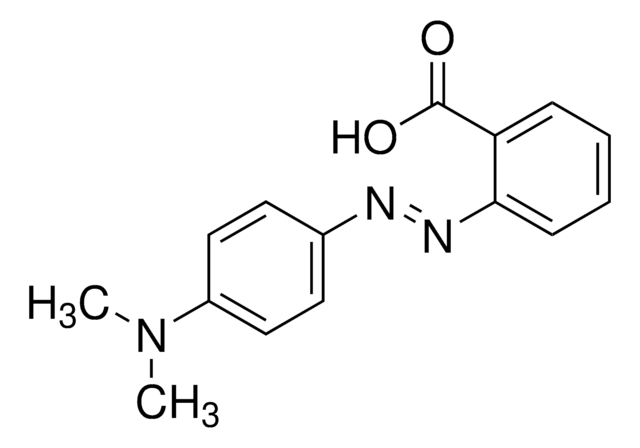추천 제품
Agency
according to GB 4789.30-2016
according to ISO 22964:2017
Quality Level
제품 라인
BioChemika
유통기한
limited shelf life, expiry date on the label
구성
dist. water, 200 mL
ethanol 95%, 300 mL
methyl red, 0.1 g
기술
microbe id | metabolite detection: suitable
응용 분야
clinical testing
environmental
food and beverages
microbiology
적합성
Enterococcus spp.
Escherichia coli
Klebsiella spp.
Proteus spp.
Pseudomonas spp.
Staphylococcus spp.
bacteria
SMILES string
CN(C)c1ccc(cc1)\N=N\c2ccccc2C(O)=O
InChI
1S/C15H15N3O2/c1-18(2)12-9-7-11(8-10-12)16-17-14-6-4-3-5-13(14)15(19)20/h3-10H,1-2H3,(H,19,20)/b17-16+
InChI key
CEQFOVLGLXCDCX-WUKNDPDISA-N
유사한 제품을 찾으십니까? 방문 제품 비교 안내
일반 설명
애플리케이션
신호어
Danger
유해 및 위험 성명서
Hazard Classifications
Eye Irrit. 2 - Flam. Liq. 2
Storage Class Code
3 - Flammable liquids
WGK
WGK 1
Flash Point (°F)
69.8 °F
Flash Point (°C)
21 °C
개인 보호 장비
Eyeshields, Faceshields, Gloves, type ABEK (EN14387) respirator filter
이미 열람한 고객
문서
There are many other methods of detection to indicate the presence of E. coli. Review common tests and biochemical reactions for this contaminant.
For microbiologists the most fundamental stain was developed in 1884 by the Danish bacteriologist Hans Christian Gram.
An article concerning the detection, identification, differentiation, and cultivation of Pseudomonas species.
자사의 과학자팀은 생명 과학, 재료 과학, 화학 합성, 크로마토그래피, 분석 및 기타 많은 영역을 포함한 모든 과학 분야에 경험이 있습니다..
고객지원팀으로 연락바랍니다.










